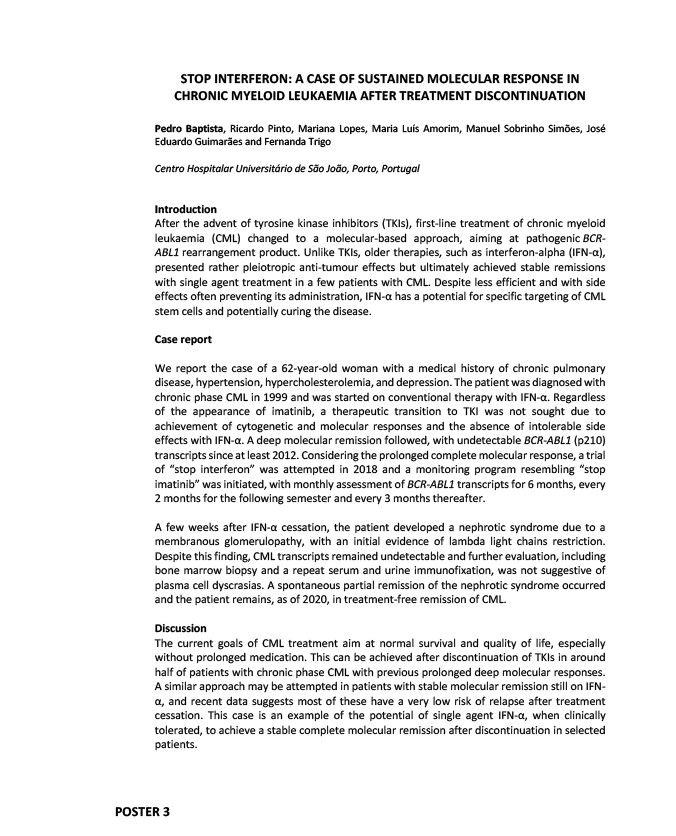
POSTER 3
STOP INTERFERON: A CASE OF SUSTAINED MOLECULAR RESPONSE IN
CHRONIC MYELOID LEUKAEMIA AFTER TREATMENT DISCONTINUATION
Pedro Baptista, Ricardo Pinto, Mariana Lopes, Maria Luís Amorim, Manuel Sobrinho Simões, José
Eduardo Guimarães and Fernanda Trigo
Centro Hospitalar Universitário de São João, Porto, Portugal
Introduction
After the advent of tyrosine kinase inhibitors (TKIs), first-line treatment of chronic myeloid
leukaemia (CML) changed to a molecular-based approach, aiming at pathogenic BCR-ABL1
rearrangement product. Unlike TKIs, older therapies, such as interferon-alpha (IFN-α),
presented rather pleiotropic anti-tumour effects but ultimately achieved stable remissions
with single agent treatment in a few patients with CML. Despite less efficient and with side
effects often preventing its administration, IFN-α has a potential for specific targeting of CML
stem cells and potentially curing the disease.
Case report
We report the case of a 62-year-old woman with a medical history of chronic pulmonary
disease, hypertension, hypercholesterolemia, and depression. The patient was diagnosed with
chronic phase CML in 1999 and was started on conventional therapy with IFN-α. Regardless
of the appearance of imatinib, a therapeutic transition to TKI was not sought due to
achievement of cytogenetic and molecular responses and the absence of intolerable side
effects with IFN-α. A deep molecular remission followed, with undetectable BCR-ABL1 (p210)
transcripts since at least 2012. Considering the prolonged complete molecular response, a trial
of “stop interferon” was attempted in 2018 and a monitoring program resembling “stop
imatinib” was initiated, with monthly assessment of BCR-ABL1 transcripts for 6 months, every
2 months for the following semester and every 3 months thereafter.
A few weeks after IFN-α cessation, the patient developed a nephrotic syndrome due to a
membranous glomerulopathy, with an initial evidence of lambda light chains restriction.
Despite this finding, CML transcripts remained undetectable and further evaluation, including
bone marrow biopsy and a repeat serum and urine immunofixation, was not suggestive of
plasma cell dyscrasias. A spontaneous partial remission of the nephrotic syndrome occurred
and the patient remains, as of 2020, in treatment-free remission of CML.
Discussion
The current goals of CML treatment aim at normal survival and quality of life, especially
without prolonged medication. This can be achieved after discontinuation of TKIs in around
half of patients with chronic phase CML with previous prolonged deep molecular responses.
A similar approach may be attempted in patients with stable molecular remission still on IFN-
α, and recent data suggests most of these have a very low risk of relapse after treatment
cessation. This case is an example of the potential of single agent IFN-α, when clinically
tolerated, to achieve a stable complete molecular remission after discontinuation in selected
patients.